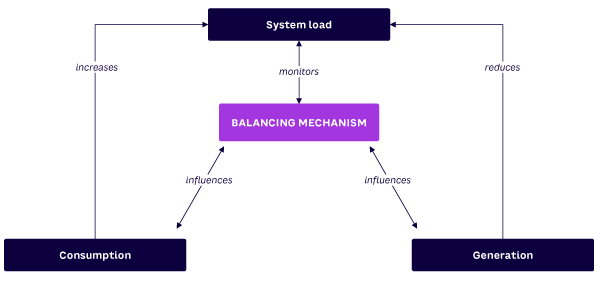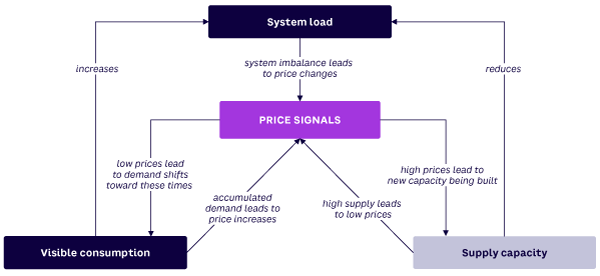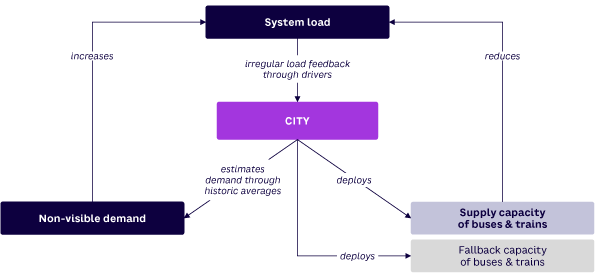AMPLIFY VOL. 37, NO. 10

The German power sector is undergoing a profound transformation that is fundamentally changing the way we generate, consume, and manage power. Historically, power systems have been governed by complex, highly regulated mechanisms, designed to ensure that supply meets demand while maintaining grid stability. With the rapid advancement of digital technologies, the industry is moving away from this centralized approach toward a more efficient, self-regulating system. This shift represents a significant evolution in how power is managed and consumed, and it promises to close the feedback loop between power consumption and creation, bringing substantial benefits to consumers, the energy transition, the grid, and society at large.
The convergence of power systems and digitalization is unlocking new levels of efficiency, transparency, and sustainability. Through advancements such as real-time data collection, smart meters, and dynamic pricing, power markets are being reshaped. This shift is essential for improving system efficiency and critical for the successful integration of renewable power sources, which are inherently variable. Digitalization provides the necessary tools to manage this variability, ensuring that power is available when needed while maintaining the balance of the grid.
This article explores how the German power economy is transitioning from a highly regulated, manual system to one driven by digital innovation. We examine the challenges of the pre-digital power economy, the transition to a digital model, and the numerous advantages this transformation offers for consumers, the power grid, and society.
Overarching Framework: The German Power Economy
To understand the scale and significance of the changes taking place within the German power economy, it is useful to view the system through an abstraction of its key players and activities, both in its current form and the target state. The complete power economy is, of course, a lot more complex, and the players have many more roles than the ones discussed here.
The framework in Figure 1 focuses on two interdependent processes (consumption and generation) that have an influence on a shared resource (system load) and are kept in balance by a central element (the balancing mechanism).

As in many developed nations, the German power economy has long relied on analog systems that offer limited visibility into real-time consumption and generation patterns. Most readers probably still have an analog power meter with a spinning disc in their cellar. In 2023, about 99% of the power economy was still in this pre-digital state in which neither time, place, nor the amount of power consumption was available in real time.1 This lack of transparency leads to several challenges.
The most pressing is the need for a central regulated monopoly, in this case, the Transmission System Operator (TSO), to ensure that generation meets consumption at all times. As we can’t store significant amounts of power, electricity must be consumed the moment it is generated, making balancing the grid especially difficult.
Because the grid lacks real-time data, the involved parties rely on average consumption patterns across all consumers based on single historical studies to ensure that enough supply is available. These patterns are called “standard load profiles.” This leads to inefficiencies, as the TSO must maintain large reserves of backup capacity to compensate for over- and under-supply at any given time.
This one-size-fits-all approach to consumption estimation and grid management means that differences between consumption and production are often balanced by having extensive backup power sources, such as gas power plants or pumped-storage facilities, which is costly and inefficient.2
The lack of real-time data also means that electricity pricing is disconnected from market conditions. Consumers typically pay a fixed rate for electricity, regardless of when or how much they use, which removes any incentive to shift consumption to times when power is less expensive or more abundant and leaves supply struggling to match demand.
Figure 2 shows the framework adapted to the current situation. Consumption and supply capacity need to be balanced for the system load not to tilt in one direction. In the middle sits the TSO as the regulated monopoly that monitors the system load (frequency of the grid) and uses workarounds like standard load profiles to estimate consumption and ensure enough supply is available for a balanced system. This is primarily done by having enough supply planned for the expected demand and dispatching fallback supply capacities as needed to compensate for estimation errors.

Transitioning to a Digital Power Economy
The key to overcoming these challenges lies in digitalizing the power economy. At the heart of this transformation are smart meters, which provide real-time data on time, place, and amount of power consumption. These devices record how much power is consumed at 15-minute intervals and transmit this information to both the consumer and the power provider.
This seemingly simple change has profound implications. With real-time data on consumption, power providers can accurately bill customers based on actual usage, rather than relying on estimates. Moreover, the data supports the introduction of dynamic tariffs, in which the price of electricity fluctuates based on market conditions.
During times of high demand or low supply, prices increase, encouraging consumers to reduce or shift their consumption. Conversely, when renewable power is abundant, prices drop, incenting consumers to use more electricity or shift consumption to these periods.
Dynamic pricing closes the feedback loop between power consumption and generation, letting consumers actively manage their power use in response to real-time pricing. This setup not only makes the system more efficient, it helps integrate more renewable power into the grid, as consumers are encouraged to shift their consumption to times when renewable power generation is high.
For example, electric vehicle (EV) owners can charge their vehicles overnight when electricity is less expensive due to low demand or when wind power is abundant.
Looking at Figure 3, we see many new connections between the now-visible consumption and the supply capacity, leading to a largely self-regulating system. The regulated monopoly in the middle is absent in this diagram, as the price signal takes over the role that this article focuses on (of course, it is still needed but to a lesser extent and for other roles).
The diagram demonstrates how the feedback loop between consumption and supply has been effectively closed through dynamic price signals. For instance, when supply capacity is high (such as on a sunny day with abundant solar energy from photovoltaic panels) prices drop, encouraging consumers to shift their energy use to lower-cost periods.
As demand accumulates during these hours, prices naturally rise again, balancing the system. The increase in demand during periods of high renewable generation further incents investment in additional renewable capacity, such as solar and wind. As more renewable energy infrastructure is developed, the cycle repeats, accelerating the transition to a carbon-free energy supply and creating a virtuous loop that drives the system toward greater sustainability.

Advantages of a Digital Power Economy
The digitalization of the power economy offers numerous advantages for consumers and society. These benefits can be grouped into three categories: for consumers, for the energy transition, and for the grid.
For Consumers
One of the most immediate benefits is the potential for reduced energy costs. By shifting their consumption to times when electricity is less expensive, consumers can take advantage of dynamic pricing to lower their bills.3
For example, homeowners with heat pumps can schedule them to run during periods of low-cost power, reducing their power bill. For consumers who have installed home batteries, the benefits are even greater, as they can store inexpensive power for use during more expensive peak times.
Companies are already offering integrated home energy management solutions that connect to all high-consumption household appliances and steer them based on the price signals of a dynamic tariff, allowing the customer to relax and enjoy inexpensive, sustainable power.
Additionally, real-time data on power consumption gives consumers greater visibility into their usage patterns, helping them make more informed decisions about how and when they use electricity.
This level of transparency and low electricity prices make it easier for consumers to electrify other areas of their household, such as transportation and heating. As the cost of electricity decreases and becomes more predictable, the economic case for switching to EVs and heat pumps becomes more compelling.
For the Energy Transition
Renewable power sources like wind and solar are at the heart of reducing carbon emissions and combating climate change. However, their variability poses a challenge to grid stability if the supply is not matched by demand. By passing real-time price signals onto consumers, the digital power economy helps customers follow the rhythm of sun and wind. When renewable power is abundant, prices drop, encouraging consumers to increase consumption. This makes it easier to integrate renewable energy into the grid and reduces the need for backup generation from fossil fuels.
The more consumers can align their power use with renewable energy generation, the more attractive it becomes to invest in renewable energy infrastructure. As demand for clean energy grows, so will financial incentives for developing additional renewable capacity. This virtuous cycle helps accelerate the transition to a low-carbon economy.
For the Grid
The availability of real-time consumption data dramatically improves grid management. In the pre-digital world, grid operators had to rely on estimates and historical data to predict consumption patterns. Now, consumption forecasts can be adjusted depending on the real-time consumption of users.4 With real-time data, grid operators can make more accurate predictions about demand, reducing the need for expensive reserves.
Moreover, as consumers shift their power use to off-peak times in response to dynamic pricing, the overall demand on the grid becomes more balanced.5 This reduces strain on the infrastructure, allowing the grid to operate more efficiently and transport more power without the need for costly infrastructure investments.
In this way, digitalization helps optimize the use of existing grid infrastructure, reducing both operational costs and the need for additional investment, reducing the grid costs consumers must pay.6
A Meta View of the Power Sector’s Transformation
The transition from a pre-digital to a digital power economy can be viewed as the closing of a crucial feedback loop between two interdependent processes: power consumption and generation. In the analog world, these processes operated largely independently, necessitating a regulating party in the middle to maintain balance. This is achieved by manual intervention and costly workarounds. In the power economy, the grid operators take on that role.
By introducing real-time data and a signal that connects the processes, digitalization allows the system to regulate itself. Consumption and supply are directly linked through a signal, which provides the feedback necessary for consumers and generators to adjust their behavior in real time. This system reduces the need for manual intervention, lowering operational costs and improving overall efficiency.
The key factors driving the transition are the availability of real-time data and the presence of a central signal (in this case, price) that both consumers and producers respond to. By aligning these two processes, a more balanced, efficient, and sustainable system is created.
Public Transport Case Study
The concept of a closed feedback loop is not limited to the energy sector. A similar situation exists in public transportation (and many other industries where the system operates in an open loop). The number of buses and trains deployed is based on historical data and fixed schedules, with no real-time feedback about demand (see Figure 4). This leads to inefficiencies, as vehicles may run empty during off-peak hours or become overcrowded during peak times. Identifying some peak times is easy (e.g., children on their way to school), but other peaks and valleys are unpredictable: a cold wave that leads to many office workers staying home or a popular event that leads to an overload of a single connection.
By integrating real-time data on passenger movement (potentially collected via telecommunications networks) and implementing dynamic pricing, the feedback loop in public transport can be closed. Off-peak discounts incent passengers to travel during quieter times, reducing strain on the system and improving efficiency. Or the city could shift capacities from one connection to another based on the live data. This would prevent overcrowding and dissatisfaction.

Lessons from Germany’s Digital Power Transition
Germany’s transition to a digital power economy offers several lessons that can be applied across industries:
-
Data gathering. The importance of starting early with data collection cannot be overstated. Without accurate, real-time data, digital initiatives will fail to reflect the true state of processes, leading to inefficiencies and missed opportunities. In Germany, delays in rolling out smart meters have hindered the transition to a fully digitalized power economy. The lesson here is to prioritize data collection and focus on building a solid foundation before layering on complexity.7
-
Data processing capabilities. Access to real-time data is only valuable if it can be effectively processed and acted on. In Germany, grid operators have struggled to adapt to modern data processing practices, slowing the adoption of digital solutions.8 Early build-out of robust data processing capabilities, both technology and human expertise, is essential to making full use of the data collected.
-
Synchronous regulation and process changes. As digital systems take over many tasks that are managed manually, regulatory frameworks and processes must evolve in parallel. In Germany, the static nature of grid costs has deterred consumers from shifting their power use, limiting the effectiveness of dynamic pricing.9 Introducing dynamic grid pricing, which reflects the actual strain on infrastructure, would further incent consumers to adjust their behavior and help optimize the system.
Final Remarks
The digitalization of Germany’s power economy demonstrates the immense potential of self-regulating systems to improve efficiency, reduce costs, and support the transition to a low-carbon economy. By leveraging real-time data and dynamic pricing, power consumption can be aligned with supply, creating a more balanced and sustainable system. As industries around the world undergo digital transformations, the lessons learned from Germany’s power sector provide a valuable blueprint for harnessing the power of self-regulation to unlock new levels of efficiency and sustainability.
References
1 “Die Energiewende in Deutschland: Stand der Dinge 2023” (The Energy Transition in Germany: State of Play in 2023“). Agora Energiewende, 4 January 2024.
2 “Monitoring Report 2023.” Bundesnetzagentur/Bundeskartellamt, accessed October 2024.
3 “Haushaltsnahe Flexibilitäten Nutzen” (“Use Budget-Related Facilities“). Agora Energiewende, 9 December 2023.
4 Agora Energiewende (see 3).
5 Agora Energiewende (see 3).
6 Agora Energiewende (see 3).
7 Babilon, Linda, Manuel Battaglia, and Moritz Robers. “Energy Communities: Accelerators of the Decentralised Energy Transition.” German Energy Agency (DENA), March 2022.
8 “The Power of Flex: Enabling Consumers to Benefit from the Energy Transition.” Elia Group, November 2023 (not available online).
9 “Klimaneutrales Stromsystem 2035” (“Climate-Neutral Electricity System 2035”). Agora Energiewende, 23 June 2022.



